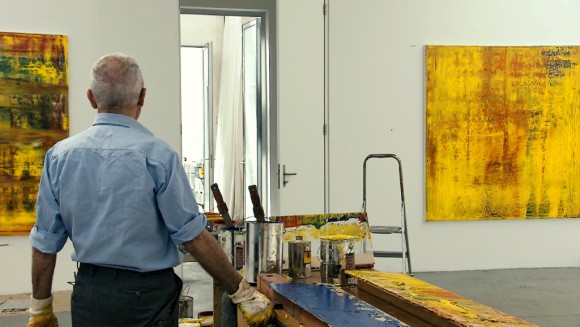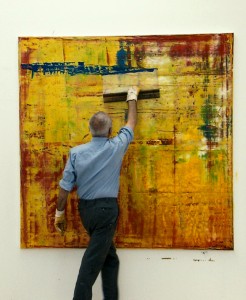ART ON FILM: Gerhard Richter doc reveals ‘secretive business’
Posted on August 24, 2012 By Barry Hammond Culture, Film, Front Slider, Visual Arts
 Paint. The thickness of it. The sensuousness of its colours. The textures of its application. The weights and balances, lines of force, harmonies and dissonances of its composition on a plane. The resonances of emotions and ideas it leaves hanging in the eye and the mind.
Paint. The thickness of it. The sensuousness of its colours. The textures of its application. The weights and balances, lines of force, harmonies and dissonances of its composition on a plane. The resonances of emotions and ideas it leaves hanging in the eye and the mind.
These are the subjects – foreground and background – of “Gerhard Richter – Painting,” an insightful documentary by Corinna Belz, which opens at The Metro Cinema this weekend.
The film presents the great living artist in a variety of settings: at work in his studio, attending his gallery showings, meticulously planning shows with the use of small photos and miniature gallery models. Belz also portrays assistants preparing the physical aspects of Richter’s work, cleaning and straining the paint, taking the photographs the artist uses in his planning, making their own comments on how they see his work.
 It’s physical work. The most striking aspects of Richter that comes through vividly in the film is that sheer drive to create, his love of manipulating paint. He’s produced a huge body of work and it’s not because he’s a clever theorist, a cunning businessman, or was fashionable or lucky (though he is all of those things, too). He does the job. He paints – putting his skill on the line over and over, risking the vagaries of luck and chance. The work is also mental. Once the piece is done, he contemplates the results, living with the product for a period of time. He’s a critic with a masterful eye, deciding when a piece is “finished” or needs revision, even to the point of stopping, painting it over, or starting from scratch.
It’s physical work. The most striking aspects of Richter that comes through vividly in the film is that sheer drive to create, his love of manipulating paint. He’s produced a huge body of work and it’s not because he’s a clever theorist, a cunning businessman, or was fashionable or lucky (though he is all of those things, too). He does the job. He paints – putting his skill on the line over and over, risking the vagaries of luck and chance. The work is also mental. Once the piece is done, he contemplates the results, living with the product for a period of time. He’s a critic with a masterful eye, deciding when a piece is “finished” or needs revision, even to the point of stopping, painting it over, or starting from scratch.
For the uninitiated, a few facts: Gerhard Richter is a German artist, born in Dresden, who grew up in East Germany but fled to the west in 1961, first to Düsseldorf and, later, Cologne. His work encompasses a wide variety of styles, from large color abstract paintings to portraits based on photographs, also landscapes, painted glass, still lifes of candles and skulls in the memento mori fashion. If there’s any common thread to his work it may be in his use of a brush or squeegee to “blur” the paint with a striking textural effect, but even this trait isn’t universal. Richter’s five decade career has garnered both controversy and renown, and his work is said to command the highest prices of any current living artist.
But the man, the art, and this film have a complex relationship with each other. When asked if fame is a burden or if he just ignores it, Richter replies, “You can’t, can you? It varies… it’s wonderful, but you have no time to paint. That’s a problem. You can suffer.”
The process of being filmed while painting makes him uncomfortable, too, and it brings the whole enterprise into question. He talks about painting under observation being “the worst thing there is – worse than being in the hospital.” He says that knowing the camera is watching even makes him walk differently, echoing Brian Eno’s quote from “Words For the Dying,” Rob Nilsson’s 1990 film about why he objected to a documentary being made about him and John Cale in the first place: “When there’s a camera around me, I’m not behaving normally. What happens is that I censor my own behaviour… I censor that part of it that’s likely to lead to something interesting.”
Richter continues in that vein, contending, “Painting is a secretive business anyway,” and tries to explain why, ultimately confessing that he doesn’t understand it either.
It’s this tension between the public and private aspects of any art which makes films like this so interesting to watch.











